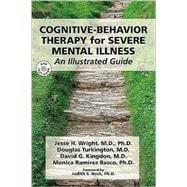
What is included with this book?
Jesse H. Wright, M.D., Ph.D., is Professor and Associate Chair for Academic Affairs at the University of Louisville School Of Medicine in Louisville, Kentucky.
Douglas Turkington, M.D., is Professor of Psychosocial Psychiatry, Department of Neurology, Neurobiology, and Psychiatry, at the University of Newcastle-upon-Tyne, Royal Victoria Infirmary, in Newcastle-upon-Tyne, United Kingdom.
David G. Kingdon, M.D., is Professor of Mental Health Care Delivery, Department of Psychiatry, at the Royal South Hants Hospital and University of Southampton, United Kingdom.
Monica Ramirez Basco, Ph.D., is Clinical Associate Professor, Department of Psychiatry, Division of Psychology, at the University of Texas Southwestern at Dallas, in Dallas, Texas.
| Foreword | p. xi |
| Preface | p. xv |
| Acknowledgments | p. xix |
| Introduction | p. 1 |
| Why Use CBT for Severe Mental Disorders? | p. 2 |
| The CBT Model for Severe Mental Illnesses | p. 4 |
| Overview of Treatment Methods | p. 12 |
| Efficacy of CBT for Severe Mental Disorders | p. 19 |
| Summary | p. 21 |
| References | p. 22 |
| Engaging and Assessing | p. 29 |
| Influences on the Therapeutic Relationship | p. 30 |
| Guidelines for Engaging a Person With Severe Mental Illness | p. 37 |
| Assessment | p. 45 |
| Indications for CBT | p. 47 |
| Summary | p. 48 |
| References | p. 49 |
| Normalizing and Educating | p. 51 |
| Normalizing Schizophrenia | p. 51 |
| Normalizing Bipolar Disorder | p. 62 |
| Normalizing Depression | p. 62 |
| The Therapeutic Relationship | p. 63 |
| Education | p. 64 |
| Summary | p. 71 |
| References | p. 72 |
| Case Formulation and Treatment Planning | p. 75 |
| Developing the Biopsychosocial Case Conceptualization | p. 76 |
| How to Construct and Use a Mini-Formulation | p. 94 |
| Summary | p. 97 |
| References | p. 98 |
| Delusions | p. 99 |
| Treating Delusions: Basic CBT Processes | p. 99 |
| Defining Delusions | p. 102 |
| Discussing Delusions | p. 104 |
| Modifying Delusions | p. 106 |
| Resistant Delusions | p. 114 |
| Treating Delusions in Mood Disorders | p. 117 |
| Summary | p. 122 |
| References | p. 123 |
| Hallucinations | p. 125 |
| Impact of Hallucinations | p. 125 |
| The CBT Approach to the Hallucinating Patient | p. 127 |
| Specific CBT Techniques for Hallucinations | p. 132 |
| Summary | p. 141 |
| References | p. 143 |
| Depression | p. 145 |
| Hopelessness and Suicidality | p. 146 |
| Low Energy and Lack of Interest | p. 160 |
| Low Self-Esteem | p. 168 |
| Summary | p. 177 |
| References | p. 177 |
| Mania | p. 181 |
| Mania Prevention Plan | p. 182 |
| Summary | p. 208 |
| References | p. 209 |
| Interpersonal Problems | p. 211 |
| Common Interpersonal Difficulties | p. 211 |
| Interpersonal Problems in Specific Disorders | p. 222 |
| Summary | p. 235 |
| References | p. 236 |
| Impaired Cognitive Functioning | p. 237 |
| Thought Disorder in Schizophrenia | p. 238 |
| Racing Thoughts, Distractibility, and Disorganization in Mania and Hypomania | p. 247 |
| Problems With Cognitive Functioning in Depression | p. 251 |
| Summary | p. 254 |
| References | p. 255 |
| Negative Symptoms | p. 257 |
| What Are Negative Symptoms? | p. 258 |
| The CBT Conceptualization | p. 259 |
| Demotivation in Schizophrenia | p. 260 |
| Socialization | p. 264 |
| Applying Standard Behavioral Methods | p. 266 |
| Summary | p. 270 |
| References | p. 271 |
| Promoting Adherence | p. 273 |
| Types of Nonadherence to Treatment | p. 275 |
| Common Reasons for Nonadherence: Possible Solutions | p. 275 |
| Working With Cognitions | p. 281 |
| Developing a Written Adherence Plan | p. 286 |
| CBT Homework | p. 290 |
| Summary | p. 291 |
| References | p. 292 |
| Maintaining Treatment Gains | p. 295 |
| Relapse Prevention | p. 295 |
| Methods for Continuation and Maintenance CBT | p. 303 |
| Summary | p. 312 |
| References | p. 313 |
| Worksheets and Checklists | p. 315 |
| Cognitive-Behavior Therapy Resources | p. 329 |
| DVD Guide | p. 335 |
| Index | p. 339 |
| Table of Contents provided by Ingram. All Rights Reserved. |
The New copy of this book will include any supplemental materials advertised. Please check the title of the book to determine if it should include any access cards, study guides, lab manuals, CDs, etc.
The Used, Rental and eBook copies of this book are not guaranteed to include any supplemental materials. Typically, only the book itself is included. This is true even if the title states it includes any access cards, study guides, lab manuals, CDs, etc.